The Restoration of Independence is the name given to the revolution that took place on December 1st, 1640, led by a group called The Forty Conjured and spread throughout the Kingdom. The Portuguese revolt was against the attempt to annul the independence of the Kingdom of Portugal by the governance of the Castilian Philippine dynasty.
- It all culminates in the establishment of the 4th Portuguese Dynasty - the house of Bragança - with the acclamation of D. João IV - it is also correctly designated as The Acclamation of Independence of Portugal.
- It all began at the end of the 16th century with the ascent to the throne of D. Sebastião, who in 1578 died in the battle of Alcácer Quibir, without leaving an heir to occupy the throne.
- For 60 years he lived in Portugal, a period that became known in history as the "Filipino domain". After the reign of Philip I (II of Spain), came the governance of Philip II and Philip III, who ruled both countries (Portugal and Spain), as if they were one.
- Discontented, the Portuguese nobles (although the whole society revolted against the Spanish yoke with revolts and riots that happened all over the country) prepare a revolt that they carry through with success on 1 of December of 1640.
- 60 years of Spanish rule ends this way and Portugal regains its independence.
Curiosities
- The Monument to the Restorers is a monument in honor of the victory of the Restoration War that led to the restoration of the independence of Portugal.
- Cataluña was facing internal riots and in this moment of weakness, Portugal plotted the riot that would lead to the end of the Spanish ruling. If the riots in Cataluña did not take place, the restoration of the Portuguese independence.
- The forced governmental union between Portugal and Spain was later known as the “Iberian Union”.
